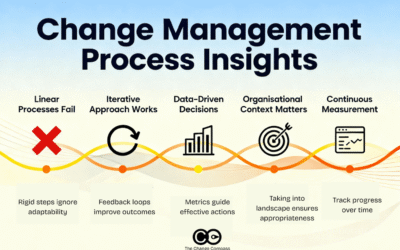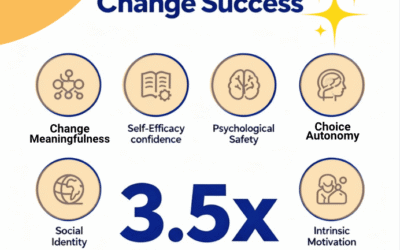In this Change Practitioner Q&A series we talk to change managers to ask them how they approach their work. This time we are talking to Fiona Johnson.
Change Compass: Hi Fiona, describe yourself in 3 sentences.
Fiona:
I’m a ‘seasoned” change practitioner who has survived many types of workplaces relatively unscathed ! Honestly, I could write a book about it.
I always try and see the positive aspects of any workplace and do my best to enhance and support the cultural norms AND keep a sense of humour.
I like to collaborate with professional and supportive team members and coach and mentor team members.
Change Compass: What has been the most challenging situation for you as a change practitioner? Tell us what happened and how you fared through it.
Fiona: I’ve had a lot of challenges, but I think the key is getting leaders to lead the change and supporting them.
I had an instance where I had to “sell” the benefits of change management to a very resistant Financial Controller. At the start of the project ( basically an operating model change) , he was totally focussed on the numbers and not the people and lacked the insight that change is always about people.
I had a team made up of business representatives and I set up regular fortnightly meetings to get his attention on issues we needed resolving and keep him up to date. I made the meetings short and sharp and each team members gave an update on the work they were doing to give them visibility. He realised the value of change management once the project delivered as that was when the gaps became evident. I think we were able to prepare him for the implementation but once the project wrapped up it was evident there was a lot of embedment activities not planned for and I think this would have caused more pain.
Although change initiatives are clearer now about the roles and responsibilities of the Sponsor and Business Owner, there is a still a reluctance amongst senior leaders to lead from the front in case it’s a failure and reflects negatively on them. I think this is an education piece and leaders need to trust change managers.
Change Compass: What are the most critical and most useful things to focus on when you first start on a project, and why.
Fiona: These tend to be the questions I focus on …
• What are the business drivers? Why? Because this helps form the narrative and links to strategy and then to the frontline – “What’s in it for me?”
• Who is the Sponsor and how actively engaged are they? They need to be involved and advocating throughout the project.
• How much funding is set aside for Change Management ? I’ve implemented change on a shoestring but its better if there is funding for communication and training as this indicates consideration for the recipients.
• What’s the organisations history of managing change – is there a “good” change example and what made it stand out, conversely what was a poor experience and what factors contributed to it ?
• What is the culture like ? Take note of employees’ surveys as they provide markers on morale and pain points.
• Finally identify a network of strong champions and advocates to help the change and provide them with the tools to do this.
Change Compass: As change practitioners we don’t often get to stick around to see the fruits of our labour, but from your experience what are the top factors in driving full change adoption?
Fiona: For me ….
• Understanding the future state and identifying existing organisation metrics that can monitor and measure, or if there are gaps, ensuring these are filled before the change.
• Handover to a committed business owner to manage and maintain momentum and who understands their role and responsibilities.
• Building governance structures to review and report on the changes to the Executives or using existing forums.
• Reporting and tracking are key but also other types of controls such as operating procedures and training.
• Involving other areas such as QA, Compliance, HR and Finance in the discussions relating to embedment
Change Compass: You’re known to be great at explaining complex changes to stakeholders. What’s your secret?
Fiona: I have the grandmother test … would your grandmother understand this?
Also, use basic communication rules such a targeting your audiences – there’s a difference between communicating to white collar and blue collar. Other tips include …
• Use storytelling and personas your audience can relate to
• Use your advocates and sponsors to spread the message.
• Keep it simple and use a variety of mediums
Change Compass: Great insights! Thanks Fiona!
Also check out our Change Practitioner Q&A with Alvaro Pacheco.






